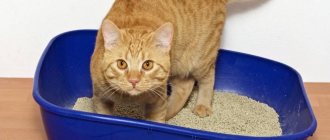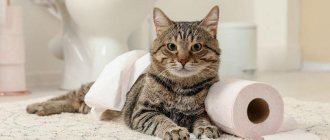Many people encounter this problem: the cat begins to shit on the bed. Do not try to spray the bed with products or cover it with diapers, this will not help you get rid of the habit. Poking a cat's face into its piles and puddles is useless!!! You can punish only if the animal is caught at the time of committing a crime . Under no circumstances should you punish with your HANDS!!! The owner’s hands cannot be an instrument of punishment, because for the cat they should be associated only with affection and care. You can punish a cat if you managed to catch it, by slapping it with a newspaper or a rustling plastic bag, or by spraying it with water from a spray bottle (if you have one at hand).
If the cat has already managed to misbehave during your absence, then all punishments will only further ruin your relationship with the cat. We need to look for the reason, the motivation, why she behaved this way. When cats do their business in the most visible place, it means that they are shaking their rights and proving their power and greatness to the whole world. A cat that does not consider itself the “ruler of the world” will do all its business in a specially designated place and then try to carefully “bury” the piles and puddles. Left at home alone, the cat either felt like the MISTRESS of the apartment and announced this - by checking in on the bed. Or she was upset that they forgot to put her food, in retaliation, putting an “offensive pile” under the hostess’s nose. Based on WHAT was the cause of her dissatisfaction, it is necessary to look for a solution to the problem.
Reason: not happy with the place
Any living creature feels vulnerable during urination or defecation. But if you understand that there is no threat in the apartment, then the cat does not understand. He is driven by the ancient instinct of self-preservation. Some cats can do their business in front of everyone right in the middle of the room, moreover, at this moment they need company. Others are so anxious that they only want to go to the toilet in a secluded place. If your cat is like this, try to place the litter box away from walk-through areas and buy a house tray.
Tray training a kitten
You need to start raising a pet from a young age .
He will need a special tray that needs to be kept clean. The filler should be selected taking into account the age of the animal, as well as the length of its fur. When the baby appears in the house, it is worth keeping track of where he goes to the toilet for the first time. You can’t scold him for such an act , you just need to wash the floor thoroughly and remove any manifestations of a specific smell.
A tray is installed in this place, into which the kitten can climb without problems. The next time the animal looks for a secluded place, worry, you need to carefully move it to the tray .
It is important to talk to him gently, calm him down, and sit him on the filler. Special sprays can help with such training . If you find time and patience, you won’t need to stop your kitten from crapping in your living room or on your bed.
Is your kitten healthy?
The most common ailment that leads to ignoring the tray is urolithiasis. Practice shows that urolithiasis is extremely rare in kittens. It is much more likely to ignore the tray due to a cold or cystitis. If your kitten suddenly stops using the litter box, you should take him to the vet before taking any action.
Analyze after what events the kitten began to crap in the house. Perhaps we bathed him, took him to the veterinary clinic, treated him for fleas or worms. Taking any medical or preventative medications can have side effects. Failure to completely dry the coat after bathing can lead to hypothermia. A visit to the veterinary clinic may result in a viral disease, especially if the kitten has not received vaccination.
What to do?
There seems to be nothing to scold or punish the animal for - it does everything in the right place. In addition, if you make a cat nervous when visiting the toilet, it may well begin to look for a calmer and quieter place for its needs. Read more about this in the article 'How to train a kitten to use a litter box'
In the end I tried this method. At the construction market I bought a plastic trough for mixing plaster. The dimensions of the trough are approximately 50 by 80 cm, the height of the sides is 30 cm. I removed all the old cat litter boxes and installed a new acquisition in their place, pouring a thick layer of filler.
The first pancake came out lumpy. Our 10-year-old cat categorically refused to jump into some strange box. Although the 6-month-old kitten liked the trough. After thinking a little, I took a saw and cut out the front wall, leaving a 10-centimeter side. It turned out that the most convenient way to cut this cutout was with a vibrating saw - Renovator.
Manifestation of cat instincts
Some pets' natural instincts are so pronounced that they cannot relieve themselves of small and large needs in one place.
This is explained by the fact that cats associate the process of urination with the process of marking their territory, which is why they begin to walk past the litter box when defecating.
How to get out of this situation? It is recommended to place two litter boxes for your pet, but not next to each other (this arrangement of toilets will not solve the problem), but at some distance - these can be different corners of the same room, and sometimes even different rooms. Only trial and error will help you achieve the ideal placement of two toilets.
How to train a cat to use a litter box: adaptation
Regardless of the presence or absence of previous “toilet” experience, such animals experience stress when moving to a new home, weaning from their mother, or other unpleasant situations. Therefore, the following recommendation will also be useful when deciding how to accustom a cat to a new litter box. Experts advise limiting the movement of the tailed and mustachioed animals in the home to one or two rooms during the adaptation period, and not giving access to the rest for now. It is preferable that these are rooms where the owner himself spends a significant part of the time. It is necessary to monitor the pet’s behavior in order to seize the moment of acquaintance with the “toilet”.
Reason: the cat is marking his territory
The cat recently started peeing in the wrong places, but mostly goes to the litter box? Perhaps he is marking his territory. Here you will need either castration or constant mating with females so that the rut after sexual intercourse becomes dull and the need for marks disappears. Although the second option may not work, because... There are very sexy cats and those who doubt that the territory of the apartment belongs only to them, which means they continue to mark.
The problem of marks can also occur in cats, especially if there are several of them in the house. And in general, if there is more than one cat in a family, this is a provoking factor for marks. In this case, you need to try to normalize the relationship between the pets. And they need not one toilet for two, but... three. There should be one more tray than there are cats. The trays should be placed in different places: in those places where you most often find “gifts”.
Why does a cat shit in the wrong place?
Because she is overwhelmed by human feelings such as jealousy, lack of attention, high self-esteem, sadness. This is not a disease, it’s just such a difficult period, like adolescence in a person. But it can also be a signal that the cat is really sick. And in this way she wants to draw your attention to her problem. You need to think and analyze all possible options. You may need to take the cat and see a veterinarian and undergo the necessary tests. Perhaps the cat has urolithiasis, or problems with the kidneys and bladder. If these are behavioral motives, then you need to let the cat understand who is in charge in the house, you also need to understand the cat itself, or if none of the above helps, limit access to the place where it shits (as an option).
Reason: the cat does not want to poop in a dirty litter box
Many cats are terrible tidies: they will not go into a litter box that they have already used and which you have not had time to clean up. Likewise, they will not go to a toilet that has to be shared with another pet. If you are lucky and your cat is like this, you will have to constantly monitor the cleanliness of the toilet.
There are also clean people who like to go to one tray when they need a lot, and to another when they need a little. In this case, you will need two trays and place them close to each other.
Article continues after advertisement
Cleaning
First of all, remove clumps from the litter box daily and clean it frequently and thoroughly. This means discarding the old litter, washing the empty box with mild dishwashing soap and warm water, rinsing with clean water, air drying, and refilling with fresh, unscented litter (sometimes scented material can be unappealing to picky cats).
Whenever you interact with the litter box, always use rubber gloves and a face mask to protect yourself from microscopic insects and dust.
Warning
If you are pregnant, delegate all litter box care to another family member to reduce the risk of contracting toxoplasmosis.
Safety
When a cat relieves itself, at this moment it is as unprotected as possible, therefore, if it is uncomfortable on the tray, there is no feeling of security, it will prefer to ignore trips to its toilet. To save space, owners often place cat litter boxes in too secluded, dark places, such as niches. Or the tray is squeezed into the tight space between the bathroom washing machine and the wall.
If your pet feels uncomfortable on the tray, don’t be surprised that he will simply start to ignore it.
The cat litter box should be located so that the cat has several approaches to it, and from different sides. In addition, there should be enough space around it.
Stress
Your cat may be trying to tell you that she is stressed at home. The pet may be unhappy with another animal in the house and will mark its territory to send a message to the other animal.
Or the cat may think that going to the litter box is dangerous if another animal is nearby. She can also do this if there is a new person in the house.
Cats are sensitive to the slightest changes in their environment. No matter what the source of stress is, make sure your cat has a quiet place to retreat to. No new animal or person should have access to this shelter.
How to fight?
Don't yell at the cat. It is worth talking to the cat in a calm tone. If the cause is JEALOUSY (very often such problems arise among owners who have small children under the age of 3, as well as those who keep several cats, or other animals besides a cat), then you should prove to the cat that you love only her . Spend more time with her, play more.
. Very often, small kittens, like children, are put in waterproof diapers in the nest basket - they are comfortable and hygienic, they are easy to change when they get dirty, the kittens grow, they begin to walk “for minor needs”, not yet knowing the tray, right on such a diaper. And with age, this topic remains in my head - the opportunity to go to the diaper. Just like cats have a desire to step over their paws, knead, and purr, their owner for the rest of their lives (this is what he does when he suckles his mother). Instead of a diaper, a soft cotton cloth can be used in the nest, which can also evoke some childhood memories and the desire to go to the toilet on a cloth. Usually by the age of 2 months such desires disappear (cats are clean animals). And if you have a small child and you use such diapers, then the advice is - you took a kitten that is still quite small, be patient and wait until the kitten grows up, or do not let the kitten near the crib.
But if the reason is LACK OF ATTENTION , it’s worth tinkering with the cat. Give it at least one hour a day, or ask the children to cuddle the cat more and play with it. There is a wonderful tool - a laser pointer beam. This toy allows the cat to run around and play to its heart's content, and the owner can play without getting up from his chair.
Resentment (one of the options for lack of attention). Watch your behavior and your cat's on the day she poops on the bed. Something in common may emerge - for example, she came to talk to you in the morning, and you brushed her off - so resentment and revenge in the form of a pile or puddle on the bed. Or the food was not put out right away and a whole bunch of other “little things” for you, but not for the cat.
HIGH SELF- ESTEEM is indeed a problem. If a cat jumps on the sofa, sit next to him, thereby showing that you also deserve this place (and do this in many ways. Not always - otherwise the cat will be offended. Just often). But if the cat gets really impudent, you should wag your finger. It should be like this all the time.
SADness is also a small problem. Add some excitement to your cat, play with it or make it an interesting toy.
No access to tray. And sometimes the most trivial problem happens - the cat was accidentally left in a room with a bed and was locked. The cat has nowhere to go, she can “go” to the bed (remembering that as a kitten she went to the cloth).
I don't like the tray or filler . This is a separate topic about the cat litter box. But it is precisely for this reason that sometimes cats refuse to go to the tray offered by the owners.
How to stop a cat from shitting: tips and tricks
Many cat owners who are faced with the problem of their pet defecating in the wrong places probably doubt that these animals are clean by nature. All your doubts are in vain. Cats were and remain, to this day, one of the cleanest living creatures. What happened that your sweet, beloved creature turned into a nasty, vengeful monster? Of course, problems with cat litter can infuriate even the most cold-blooded owner and literally destroy your sweet family life. However, in this situation, no matter how gloomy it may seem to you, there is a completely simple and effective way out: to determine the nature of the problem and eliminate the negative factor, and not at all get rid of the poor creature. It is quite possible to stop a cat from crapping. And the first thing you have to do is find out, understand what prompted your cute creature to shit where it shouldn’t. A cat urinating and defecating outside of its own litter box is a cry for help that should never be ignored. If you find that your animal does not use the container intended for these purposes and is in excellent shape, then with such extreme behavior it attracts you to its problems that require a delicate solution. The cat does not behave this way out of harm, and the problem requires your close attention before such extreme behavior turns into a persistent bad habit. By observing the location of urine or feces and your pet's use of the litter box or complete refusal to use it, you can easily determine the nature and cause of the problem. Why does a cat shit? Finding the actual cause of your cat's deviant behavior will require you to do some investigation. And although in each individual case the reasons may be different, there are still a number of the most common and common ones. Unfortunately, most owners know little or nothing about the first weeks of their pet's life. This is significant because a kitten's lack of human interaction during the sensitive period of two to seven weeks can lead to agitated behavior in the presence of humans and poor ability to adapt to changes in the environment in the future. In general, individuals who are less sociable and have a more vulnerable nervous system are much more likely to exhibit reactive bowel movements. So, in order to stop a cat from crapping, you first need to identify the reason:
- Illness or tray as a predictor of painful experience. The cause of pain must be considered before other causes. Health problems that cause pain during defecation or urination often cause animals to poop outside the litter box. In this case, it will either completely abandon the tray, or will only perform actions there that do not cause pain. Constipation, worms, and various diseases of the genitourinary system can force your cat to shit. Contacting a veterinarian is the only correct solution in this situation.
- Problems with the tray. - the cat doesn’t like the litter box The cat may not like the size of the litter box, which should be at least one and a half times longer than the cat so that she can turn around freely there. The strong smell of cleaning products or the chemical smell of cheap plastic can also make animals averse to their own litter box. Let's remember that cats' sense of smell is 14 times better than ours. Successful attempts to completely remove cat odor from the litter box may also remove the animal's association with the litter box. The solution to the problem in this case is to wash the cat's litter box with water and a drop of liquid soap, rather than strong cleaning agents. A cat may shit near the litter box if the litter is too dirty and the smell of urine is too concentrated, or if other animals use the litter box. For ultra-clean and scrupulous cats, it is recommended to place two containers and constantly monitor their condition. - the cat does not like the location of the tray If the tray is located close to the cat's food bowls, then its innate instinct to avoid contaminating food areas may cause it to shit around the apartment. She will also avoid the litter box if it is located in an unprotected, vulnerable place from her point of view. This happens when a cat is disturbed by children while performing hygiene procedures, or if a roll of toilet paper suddenly falls on its head, or simply the cat litter box is located in a family activity room that is too noisy for the animal. All you need to do to stop your cat from crapping in this case is to ensure that the litter box is located in a safe and secluded place. The ideal option would be a tray house. If the location of the cat litter box must be changed due to some circumstances, then it should be moved to the new territory gradually. - the cat does not like the litter Sometimes a particular litter does not meet the requirements of a specific cat. For example, not all cats like wood pellets because the cylindrical pellets roll around under their paws. Some litters emit a strong odor when they become wet because they contain chemical ingredients, and a cat's sensitive nose cannot tolerate the strong smell. Moreover, some chemicals can irritate the sensitive skin of a cat's paws. Such performers should be avoided. In a situation where you need to transfer your pet to a new, say, more economical filler, the transfer should be done gradually, adding a new filler to the old one and changing the ratio in favor of the new one.
- Marking behavior. It's no secret that cats' communication is largely based on smell. They leave marks both to attract sexual partners and to secure rights to their territory. Defecating in the wrong place is often nothing more than just a more extreme territorial marker. Let's remember how street cats leave their feces on the ground in full view of other felines, without trying to bury them, unlike their domestic counterparts. This is why toilet training often becomes difficult with cats found on the street. In indoor cats, defecation as a marker of its own territory occurs in cases where it feels extremely insecure. At the same time, the cat shits without completely refusing to use the litter box. And if you pay attention to the areas where the cat shits, they will not be random, but will have a certain behavioral meaning, they will indicate new objects or the cat’s “old routes.” Very often, a cat begins to shit when a child, another cat or dog appears in the house. If there are too many animals gathered in a small apartment, some of them will try to defend their rights using such a radical method. Changing a place of residence, rearranging, renovating, buying new furniture causes severe anxiety in cats associated with the disappearance of familiar marks and forces them to resort to extreme methods of protecting their territory. Active marking of their possessions begins, “until other individuals claim their rights to this territory.” How to stop a cat from crapping in stressful situations? Many owners experience a real shock when a cat that has lived with them for many years suddenly begins to show such an “ugly” side of itself. In desperation, they try to quickly stop this behavior without delving into the essence of what is happening, and thereby only making the problem worse. There's really only one way to stop cat poop from ruining your life and your home: quickly but calmly take control of the situation. Remember that under no circumstances should you shout at your cat, frighten it with water from a spray bottle, or scold it. All that you can achieve with such methods is only to increase her anxiety and the number of “atrocities”. If an animal develops an association between punishment and your presence, then a real discord will arise in your relationship with it, and it will continue to crap in secret from you. Some “advisers” also advise catching the cat in the act, scolding it and dragging it immediately to the litter box, leaving numerous puddles on the floor. This behavior will eventually lead the cat to associate bowel movements with increased attention from the owner. As a result, she will begin to “sin” at moments when you turn off or switch your attention (sleeping or doing something important). Such a long prelude was written so that you are completely convinced of the futility of all methods associated with punishing a pet. The question arises, how then to wean a cat from shitting? All you have to do is make your beloved creature feel safe again. Cat psychologists recommend giving your pet a period of confinement to gradually make him feel secure in his new environment and, in some cases, re-introduce him to the litter box. Keep your cat in a small room, at least a bathroom, for about a week with her toys, water and litter box, but leave her food bowls alone, and take her out to eat two or three times a day. After a week, gradually start letting her out into other rooms until she fully adapts to the changes. Agreement with the new situation will necessarily be a consequence of the removal of excitement. This may seem like an extreme measure to some, but since we cannot explain what is happening to our cat in words, we must show her the new situation gently and gradually so that she gradually frees herself from her fear. To improve the animal’s well-being, you can also use the method of marking the territory with pheromones from the cat’s facial glands, which will be discussed at the end of the article.
- Associated urination. - urination on a “tray substitute” It may happen that some surfaces in your home will be too reminiscent of the cat’s own litter tray. For example, a carpet with long pile, which can also be easily touched with paws. In this case, the animal has a conditioned reflex to shit in this place, while often not giving up the tray completely. In this situation, in order to wean a cat from shitting, you will need to remove the carpet or other soiled object for a while in order to strengthen its connection between the tray and the latrine. In some cases, it is necessary to significantly increase the area of the toilet by connecting several trays together, like a carpet. When the animal is completely accustomed to relieving itself in only one place, the number of trays can be gradually reduced. - urinating on owner's things A cat may have decreased bladder control due to age, poor health, or nervous exhaustion. Then she might start shitting in random places. These can be places where the owner's scent is strong, for example, his clothes or bedding, because there the cat can calm down, relax and lose control of itself for a while. She may also crap on her owner's things to increase her sense of security through association, such as by causing disturbance while the owner is away. Longing for the owner can be cured only with increased care and attention. When cats shit on objects saturated with the smell of a specific person, we can definitely say that the cat’s relationship with this person is far from ideal, and it needs to be adjusted.
We exclude medicine
If the tray is always clean and smells quite pleasant, then why does the animal still not change its habit of ignoring it, defecating past it, as if out of spite? In this case, it is worth observing the animal, perhaps the development of various diseases is to blame.
The most common cause of strange cat behavior is the presence of frequent constipation in the pet. The cat begins to associate his toilet with unpleasant, uncomfortable sensations, which is why he prefers not to go to it.
Another reason for this behavior is related to the age of the cat - quite often older cats develop a disease such as arthritis. Due to joint pain and stiffness, they are simply unable to perch on a tray with high sides.
In addition, there are also psychological factors, for example, when the owner uses a closed house as a cat litter box. Of course, it looks interesting and aesthetically pleasing, it traps odors, but in most cases cats feel uncomfortable and uncomfortable in such houses, so they prefer to ignore it.
Medical problems
If your cat is peeing outside the litter box, the first step is to visit the veterinarian. The veterinarian will perform a physical examination of your pet and test a urine sample.
Based on the results, the veterinarian will recommend treatment. There are a number of common urinary problems in cats:
Bladder stones:
Some cats develop actual bladder stones, which can cause irritation and even blockage of the duct. If your vet suspects bladder stones, you will need an x-ray to determine their size and number.
Small bladder stones can be dissolved with a special diet, while larger ones can be removed surgically (cystotomy).
Idiopathic cystitis:
The term cystitis means inflammation of the bladder. Idiopathic means the cause is unknown. Cats with cystitis often have blood in their urine. A urine test is necessary because blood can only be detected microscopically.
If your veterinarian determines that your cat's urine contains blood but no bacteria or stones, the likely diagnosis is idiopathic cystitis. Idiopathic cystitis is usually treated with dietary changes. Painkillers and sedatives may also be used.
Metabolic diseases:
symptoms of chronic kidney disease may include increased urination. Other metabolic diseases that can increase the amount a cat urinates are liver disease, diabetes, and thyroid problems.
Urinary tract infections or UTIs:
Although urinary tract infections are rare in young cats, they can be a common cause of urinary problems in older cats, either alone or in combination with other diseases affecting the urinary system.
Antibiotics are used to treat urinary tract infections. Your veterinarian will likely recommend repeat tests after the antibiotics are finished to make sure the infection is gone.
What to do if your cat is sick?
When one or more urinary problems are chronic, the condition is usually called feline lower urinary tract disease.
If your cat is diagnosed with this condition, your veterinarian may recommend a special urinary diet and/or supplements to support the urinary tract.
Problems with urination can lead to severe urinary obstruction, especially in cats. If she is having trouble urinating, don't delay a trip to the vet.
If your cat strains to urinate and little or no urine comes out, she may have a blockage or partial obstruction.
If this occurs, contact your veterinarian immediately as this condition can quickly become life-threatening.
In some cases, a cat does not urinate in the litter tray when it has health problems not related to the urinary system. Your cat may urinate outside the litter box due to pain or discomfort in other parts of the body.
This is a reason to undergo a comprehensive examination. Laboratory tests can reveal serious health problems such as diabetes or kidney disease, allowing your veterinarian to begin treatment immediately.











